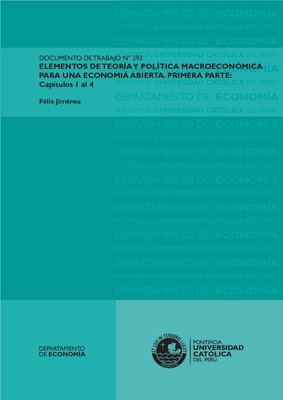| dc.contributor.author | Jiménez, Félix | |
| dc.date.accessioned | 2015-03-19T20:37:49Z | |
| dc.date.available | 2015-03-19T20:37:49Z | |
| dc.date.issued | 2010 | |
| dc.identifier.uri | http://repositorio.pucp.edu.pe/index/handle/123456789/46933 | |
| dc.description.abstract | Esta es la primera parte del libro. Consta de cuatro capítulos. Contiene una breve historia de la macroeconomía, los conceptos básicos de la contabilidad nacional, el flujo circular de la economía, y otros conceptos vinculados a una economía abierta. Los economistas clásicos, Smith y Ricardo, son considerados los fundadores de la macroeconomía pues son los primeros en estudiar el comportamiento de la economía en su conjunto: las causas de la generación de riqueza y sus límites. El segundo capítulo desarrolla los conceptos macroeconómicos necesarios para comprender las siguientes partes del libro. Se explican los distintos tipos de variables económicas y bienes económicos; la tasa de interés y el valor del dinero en el tiempo; el desempleo y la inflación. El tercer capítulo, presenta los conceptos básicos de contabilidad nacional y el flujo circular ingreso-gasto de la economía. Se desarrollan los tres métodos de medición del PBI y otros conceptos relacionados a él. El cuarto capítulo presenta los conceptos de Balanza de Pagos, el tipo de cambio y otros necesarios para comprender el funcionamiento de una economía abierta. | es_ES |
| dc.description.abstract | This is the first part of the book. It consists of four chapters which contain a brief history of macroeconomics, the basic concepts of national accounts, the circular flow of the economy, and other concepts related to an open economy. The classical economists, Smith and Ricardo, are considered the founders of macroeconomic since they were the first in studying the behavior of the economy as a whole: the causes and limits of economic growth. The second chapter develops the macroeconomic concepts that will be necessary to understand the remaining parts of the book. It explains the different types of economic variables and economic goods, the interest rate and the value of money over time, unemployment and inflation. The third chapter presents the basic concepts of national accounts and the circular flow of the income. It develops three different methods of measuring GDP and other key concepts related to it. The fourth chapter develops concepts such as Balance of Payments and the exchange rate, and others necessary to understand the functioning of an open economy. | en_US |
| dc.language.iso | spa | es_ES |
| dc.publisher | Pontificia Universidad Católica del Perú. Departamento de Economía | es_ES |
| dc.relation.ispartof | urn:issn:2079-8466 | |
| dc.relation.ispartof | urn:issn:2079-8474 | |
| dc.relation.ispartofseries | Documento de Trabajo;292 | es_ES |
| dc.rights | Atribución-NoComercial-SinDerivadas 2.5 Perú | * |
| dc.rights | info:eu-repo/semantics/openAccess | es_ES |
| dc.rights.uri | http://creativecommons.org/licenses/by-nc-nd/2.5/pe/ | es_ES |
| dc.subject | Macroeconomía | es_ES |
| dc.subject | Teoría económica | es_ES |
| dc.subject | Política monetaria | es_ES |
| dc.subject | Política fiscal | es_ES |
| dc.title | Elementos de teoría y política macroeconómica para una economía abierta. Primera parte: Capítulos 1 al 4 | es_ES |
| dc.title.alternative | Elements of a macroeconomic theory and policy for an open economy. First section. Chapters 1 to 4 | en_US |
| dc.type | info:eu-repo/semantics/workingPaper | |
| dc.type.other | Documento de trabajo | |
| dc.subject.ocde | http://purl.org/pe-repo/ocde/ford#5.02.00 | |
| dc.publisher.country | PE | |
| renati.advisor.orcid | https://orcid.org/0000-0002-0585-238X | |


